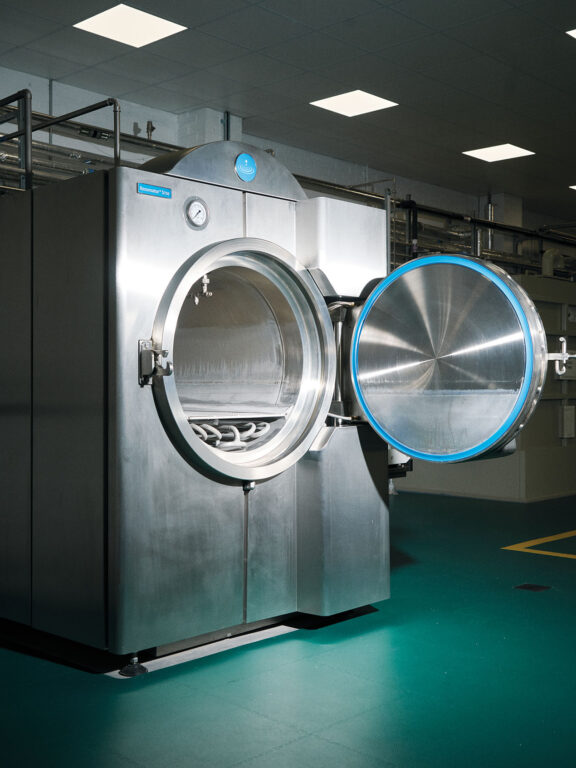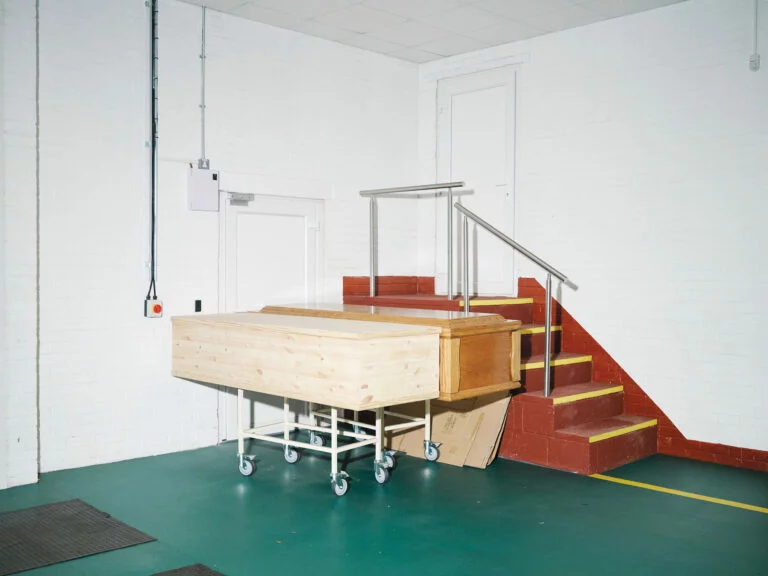If it has ever fallen to you to scatter someone’s ashes, especially those of someone you loved, you might share my sense of the process as tantamount to fly tipping, the stuff resembling nothing so much as cat litter: coarse and grey, inarguably a waste product. It is surprising how much you get. I had imagined sprinkling a few handfuls to the wind and being done with it, but on the occasion I am thinking of it took four of us about an hour, using a Persil scoop, to deposit half. The remaining kilo-or-so still sits shut in a dresser at my mother’s, a niggling source of unfulfilment. What I wanted, at the time, was for the remains to vanish altogether: puff. But anyone with a GCSE in physics knows what Antoine Lavoisier confirmed in 1789: that matter is indestructible.
It is at those points where the skin is thinnest and most quickly oxidised – the forehead, the ankles, the hips – where fire will first expose the underlying bone. The head burns from the crown to the nape, for instance, from the thinnest flesh to the thickest. The skin tightens and splits to expose fat, tendons, ligaments, organs and bones. With the protective dermis gone, fat renders and becomes a secondary accelerant. Bone turns yellow, then black, then white, finally grey. Ninety minutes have passed. The gas is switched off, the cremator cools, a technician gets to work with a rake.
You’d rather the alternative? Once blood has ceased to transport oxygen through the circulatory system, cells die and discharge digestive enzymes, breaking down the body’s soft tissues. The stomach, groin and limbs bloat, then, after a week or so – deflate. The skin discolours, sloughs. First to decompose is the head flesh, the eyes, ears and nose. Upper limbs before lower. The stomach, spleen and intestines go relatively quickly; the kidneys, heart and liver are more enduring. One by one the joints disarticulate. After eighteen months, little remains in most cases but a set of greasy bones in a cake of hard-set fluid. The body has begun its migration out into the world.
Over the course of human history most human corpses, 100 billion or more, have been either cremated or buried. Even the least conventional of us, or the least religious, might be forgiven for feeling discomfited about having to consider a third option after all this time, all these generations. We might wonder what it means for the dying and for the dead, and not only them.
Elizabeth Oakes’s Resomarium, in the town of Navan, about twenty-seven miles north-west of Dublin, is leased from an adjoining firm of funeral directors, James Fox, which in turn is attached, as such businesses often are in Ireland, to a pub, Fox’s Bar and Lounge. There is a mural of a fox and hounds but no obvious signage to indicate the premises of Oakes’s company, Pure Reflections, where I spent a morning in early December. In addition to Oakes’s desk there were in her office an empty wicker casket on a bier and, on the windowsill, three droplet-shaped ceramic urns. Otherwise the room was almost bare. From the next room, however, I felt a force, something akin to gravity. It was strange to think that the machine was just behind that locked door, in this ancient town on the confluence of the rivers Boyne and Blackwater. But then doesn’t the Large Hadron Collider lie beneath fields of French cows?
The first thing I saw when Oakes took me through was a coffin. The second was the Resomator S750, a sculpted monolith of stainless steel, at once industrial and clinical, and thus inherently terrifying. It was the size of a horse box, with a massive-hinged circular door like a submarine hatch. (A submarine hatch is precisely what it was.) It resembled something from a prison kitchen or a milking shed. The prone body, Oakes explained, would be hoisted from the coffin and slid into the unit head-first before the hatch was swung shut. With a fingertip you tap in the body’s characteristics – weight, height, sex, embalmed, un-embalmed – and the computer calculates the right volumes of water and chemical. The vessel fills with water until the body is covered. The requisite dose of potassium hydroxide, usually about 5 per cent, is added, and a heat-exchanger – a metal coil snaking under the corpse-tray – heats the mixture until, after an hour or so, the machine’s working temperature of 150°C has been achieved. The ‘Resomation phase’ initiates.
The chemical term for the process is alkaline hydrolysis. ‘Hydrolysis’ describes the destruction of chemical bonds by the insertion of a water molecule. In alkaline hydrolysis, an alkali operates as a catalyst, increasing the rate of reaction. The effect, in combination with heat and agitation, is to reduce biological material to a sterile solution. This includes proteins, carbohydrates and lipids, as well as deoxyribonucleic acid, or DNA. For an hour or two (more, if the body is big, or drenched in embalmers’ formaldehyde), the fluid is recirculated via a network of spigots. Outside, all that is audible is a muffled sloshing, like a high-end dishwasher, and the occasional pneumatic phut of solenoid valves opening or closing. After an hour or two the agitation ceases, the bath stills, the unit is cooled with a cold spray, the fluid or hydrolosate – 1,500 litres resembling weak black tea – drains away to be neutralised in a separate tank. And with a thunk-hush and an exhalation of steam, the submarine door unlatches. All that remains, across the bottom of the unit, are the bones and teeth. Once dried and ground up (about twenty seconds in Oakes’s cremulator, the same machine used in cremation), these resemble not ashes – the gritty tephra I scattered in those Hampshire woods – but something much cleaner and more homogenous, a white powder fine as talc.

When Oakes says she has always been entrepreneurial she is not just talking about a disposition for risk-taking or innovation. For her the condition presents as a hunger. When she was eight she bought two rabbits, a male and a female, with a £20 note she’d found in a bin. Soon she had thirty-six, which she sold to local pet shops at £15 each. At St Joseph’s Mercy Convent School, she developed an understanding with the nun who ran the tuck shop: Oakes would take orders from her fellow pupils and deliver their Mars bars and Taytos, keeping the change as commission. By the time she left, Ireland had joined the Eurozone and she was clearing €150 per week. She knew she wasn’t academically minded, but she was resourceful and practical, and she knew something else – in her life she wanted to make money.
She and her sister lived on a farm outside Navan, where their mother ran a saddlery. At seventy-three years old Clare Oakes can still mend your perished reins or snapped stirrup straps as well as anyone in County Meath. The smell of worked leather is one of the smells of Oakes’s childhood. One of them. During her last two years of school it was her job to care at night for her two elderly great-aunts, washing them and helping them in and out of bed and onto the commode: ‘then I’d get up the next morning and head off to school’. When the time came, Oakes helped lay the sisters out to be waked. The dead are not such strangers to the Irish as they are to, say, the English; it is still a common practice for the body to be lain out for viewing. When Oakes’s father died six years ago, a thousand people, men, women and children, attended his wake, filing through the front room past the open coffin. The family’s hands were raw from being shaken.
When she left school and moved to County Mayo, on the other side of the country, those years of stitching leather turned out to be helpful, as did caring for and laying out Great-Aunt Noreen and Great-Aunt Olive. The apprenticeship she’d signed up for was among hundreds listed on a vocational-training agency’s CD-ROM: one year as an apprentice, it said, then 40k per annum straight out the gate.
‘I remember going into my mam and being like: “Mam! I’m going to be an embalmer!” And she was like: “Oh God.”’
Finding that she had a flair for caring for the dead to match Clare’s flair for saddlery, Oakes moved to Los Angeles to take a three-year degree in Mortuary Science. The qualification was unavailable in Europe and virtually unheard-of in Ireland’s funeral sector. Pathology, mortuary law, counselling and ‘restorative arts’ (‘reconstructing ears, eye sockets, nose, eyebrows . . .’). But when she came back to Navan with her degree and a business plan for an American-style, community-centred cemetery she wanted to call Slumbering Oaks, she was met by turned backs and slammed doors. The Irish funeral industry operates more or less as it did a century ago: as a network of family monopolies, with no licensing requirements and minimal regulation. ‘“Cartel” and “mafia” – those’d be good words.’ Unlike the United States, where funeral directors must have a degree, written qualifications are not required or expected and do not necessarily work to your advantage, especially if you are a twenty-one-year-old woman, fresh from California, with powerful notions about how the sector might evolve. ‘It’s such a male-dominated industry – and older males, as well. They just didn’t want to know about me.’
The mountain, as she puts it, was too high. Oakes abandoned her cemetery idea and instead opened a business in another of the restorative arts: permanent make-up, a form of cosmetic tattooing she learned while she was in LA: ‘I remember people saying to me, “What woman in Ireland is going to let you tattoo her face?”’ It’s a mark of her instinct for what the Irish public wants that the business was soon thriving. But she hadn’t forsaken the world of ‘deathcare’. In 2017, eight years after she got back from America, she attended a funeral-industry seminar run by her old mentor from Mayo. The speakers included Damon de la Cruz, an American embalming specialist she knew from LA, who happened to mention, in passing, the growing popularity in his country of alkaline hydrolysis as a means of what is known in the trade as final disposition. It was not the first time she’d heard of the process, but she decided there and then, as Cruz was talking, that she would be the first in Ireland, and therefore Europe, to make it available to the public.
The nuns at St Joseph’s Mercy would tell you that a person’s body is a temple in which the Holy Spirit dwells. To destroy the body, even the dead body, is a sin. It is the body that is baptised, the body that is confirmed, the body that receives the Eucharist – and what is the Eucharist but the body and blood of Christ? In 1886, as cremation was emerging in Europe as an alternative means of final disposition, Pope Leo XIII issued a decree forbidding the ‘detestable, impious custom’. Two years earlier, in the winter of 1884, an eighty-three-year-old Welsh archdruid named Dr William Price carried the body of his five-month-old son Iesu Grist (Jesus Christ) to a hillside, placed the tiny personage in a cask of paraffin oil, and lit it, an act that, in avoiding the contamination of the earth, he believed to be consistent with ancient druidic practice. Price was arrested, the fire was doused, and the half-burned scrap retrieved; but once a coroner had ruled that Iesu Grist had died of natural causes, his father was released and the remains returned to him. Two months later, Price tried again, with half a tonne of coal and what remained of his son’s body. This time he was successful. Again he was exonerated, with a judge ruling, for the first time, that ‘a person who burns instead of burying a body does not commit a criminal act, unless he does it in such a manner as to amount to a public nuisance’.
A legal precedent was set. The Cremation Society of Great Britain, which opened the first British crematorium the following year, championed the practice as a hygienic, efficient and civic-minded alternative to burial. (Its motto: ‘Save the land for the living.’) But in his epic cultural history of mortal remains, The Work of the Dead, Thomas W. Laqueur observes that, in fact, ‘there were no new discoveries that would support the view that burning the dead was better for public health than burying them, and beautiful, clean cemeteries had recently triumphed over overcrowded old churchyards’. The poisonous miasmas associated with those churchyards had long since been dispelled. Nor could the embrace of cremation be attributed to any major shift in attitudes to death or religion. Instead, Laqueur says, cremation had become a way of mobilising the dead – in the interests of, among other projects, ‘anticlericalism and laicization, spiritualism, heterodox and liberal religions, socialism and materialism’. The Church’s long-standing opposition was as much a matter of rejecting a practice associated with anti-catholicism, specifically Freemasonry, as it was a liturgical prohibition. In 1963, with cremation ubiquitous in the West and the Masonic threat gone, Paul VI removed the papal ban, declaring that ‘the burning of the body, after all, has no effect on the soul, nor does it inhibit Almighty God from re-establishing the body again’. Nevertheless, ‘all necessary measures must be taken to preserve the practice of reverently burying the faithful departed’.
In Ireland, whose first crematorium did not open until 1982, cremations account for about 26 per cent of funerals, compared to 78 per cent in England. It was one thing, therefore, to try to bring a new final-disposition technology to England; quite another to introduce it to a country, a still Catholic country, where even cremation remains a minority choice after 150 years. Was our Lord hydrolised? He was not. But if the Irish public was ready for tattooed eyebrows, Oakes reasoned, why not alkaline hydrolysis?
The brochure she has had printed emphasises the environmental advantages of the procedure, that it represents a ‘more positive choice about how we leave this world for future generations’. My father’s cremation, assuming it was typical, released into the atmosphere at least 27 kilograms of CO₂ and about the same amount of pollutant nitrous oxides as a car would disgorge during a 2,300-mile journey. Say, Paris to Aleppo. Burial would have been better, but the cemeteries are almost full, we are inescapably chemical – and when we go, we do not go naked. Copper naphthenate, chromated copper arsenate, arsenic, barium, zinc, copper alloys: all are used in the manufacture of coffins. Formaldehyde is a carcinogen; chemotherapy drugs and antibiotics maintain their effects as they seep from the corpse into the soil. In alkaline hydrolysis, conversely, there is no coffin, only a woollen shroud, and even the nastiest of chemicals are annulled. What Oakes is offering is a kind of vanishment, a final act of kindness to the earth.
‘The skull is designed to protect the brain. Even in flame cremation they have sometimes to move the body to get the flames aimed at the head, to get the residual brain tissue. In alkaline hydrolysis, what happens is the head will break off quite quickly from the rest of the torso, and the brain’s in the skull, which is like a little boat. Although there’s recirculation, the brain’s sitting in the skull and the skull’s floating on the top; the chemical’s not getting to it.’
The speaker is Sandy Sullivan, the Scottish biochemist whose company, Resomation Ltd, has pioneered alkaline hydrolysis in the UK. He is describing one of the main technical challenges he has faced in bringing his machine, the Resomator, to market. A week after I met Oakes, I spent a day with him, first at the Resomation factory in Pudsey, outside Leeds, and later at a mothballed Resomation facility on the outskirts of Durham – but most instructively, as it happens, in his car during the two-hour drive in between.
‘Resomation’, the name he gave to the company he founded in 2007, is his own word. Soma is from the Greek for ‘body’, while the suffix is borrowed from ‘cremation’. Sullivan was also thinking of the founding declaration of the Cremation Society of Great Britain, written in 1874, which stated its desire to substitute for burial ‘some mode which shall rapidly resolve the body into its component elements, by a process which cannot offend the living, and shall render the remains perfectly innocuous’. The prefix ‘re-’ is important. Resomation Ltd’s logo shows two beads of water above three concentric ripples. Pure Reflections’ logo is a droplet morphing into a two-leafed seedling. The symbolism of water, and the water cycle, are crucial to what both companies are marketing. The liquid biproduct of ‘water cremation’, as Sullivan prefers to call the process, is not ‘poured down the drain’, to quote one perturbed American archbishop: it is simply restored to nature – to the glittering stream, the roaring ocean, the April shower.
The machine itself, the Resomator, is manufactured by a 150-year-old firm called the Leeds and Bradford Boiler Company, an organisation whose managing director, Howard Pickard, has engineering so deep in his bones that he can make a statement like ‘Life is very simple: just physics, chemistry, maths, that’s all it is’, and leave you wondering if he’s right. When Sullivan’s original majority shareholder, Co-op Funeralcare, Britain’s largest funeral provider, pulled out in 2016, he persuaded Pickard to buy its shares, making Resomation Ltd a division of the Leeds and Bradford Boiler Company, and Pickard its MD. The company’s trading name, LBBC, has the happy function, for anyone involved in dealing with the bereaved, of disguising its origins in industrial engineering. Its signature technology, based on a design of Pickard’s great-grandfather, is a pressure-containing door. Among its modern-day customers are Rolls-Royce, which uses LBBC’s autoclaves for precision-casting turbine blades, and BAE Systems, whose submarines the company supplies with hatch doors.
In person, as Oakes learned when she flew to England in 2016 to negotiate the terms of a contract, Sullivan has an air of warm insouciance that might be mistaken for resignation. It took me a while to realise it’s actually self-belief, albeit of a quieter form than Oakes’s. He speaks about her with avuncular affection, recalling their first meeting: ‘She goes “I want one, and I want to be the first, and I want a good deal, and I want that one, in the factory, and I want it now!”’ Oakes, who left Pudsey with an exclusive twenty-year contract to practise Resomation in Ireland, remembers it this way: ‘I had nothing to lose and they had nothing to lose.’

The use of alkaline hydrolysis as a way of disposing of the dead is usually attributed to an English chemist named Amos Herbert Hobson, who in 1888 registered a patent for a ‘process for separating gelatine from bones’. This entailed stewing livestock carcasses in a solution of boiling water and potassium hydroxide. The twin objects, he wrote, were ‘(a) to render such bones, refuse or waste more suited for fertilising purposes, [and] (b) to extract the gelatine, glue, or size’. While the process did involve alkaline hydrolysis, it is hard to see any obvious continuity between Hobson’s patent – which does not seem to have been particularly revolutionary, and didn’t dream of human corpses – and the emergence more than a century later of alkaline hydrolysis in something close to the form Sullivan and Oakes are practising. Another patent, filed in 1994 by two doctors at Albany Medical College, New York, might be a more plausible point of origin.
In biomedical research, chemical compounds will often be ‘labelled’ with a trace of tritium or another radioisotope to allow scientists to identify where the compound has been metabolised in the body – the body usually being that of a rat, mouse, rabbit or sheep. The process patented by the two doctors, Gordon Kaye and Peter Weber, promised to reduce the expense of disposing of carcasses that had been isotope-labelled, which were classified as low-level radioactive waste under government regulations. Previously, the main means of getting rid of such carcasses in the United States was in one of two special interment facilities. A single sheep could cost hundreds of dollars, as the body first had to be packed in lime and placed in its own special burial flask. In Kaye and Weber’s process, which did not differ in principle from what Hobson described a century earlier, the carcass was sunk in a mixture of water and sodium hydroxide. Their innovation was to use a pressurised steel vessel to achieve temperatures above boiling, which had the effect of expediting the process – though it still took about two hours to dissolve three rat carcasses. All that remained, other than bones and teeth, and any surgical clips or sutures, was a solution of amino acids, fatty acids and peptides whose radioactivity was well within the regulatory limits for disposal in the sewage system.
In 1994 Kaye and Weber formed a company, WR2 (‘Waste Reduction by Waste Reduction Inc.’), and gradually refined what they called their Tissue Digester. At this stage, as the name suggests, no thought had been given to applying the process to the human dead. At the time, Sandy Sullivan was living in Watford, on the outskirts of London, and employed as European vice president of Steris, an American firm specialising in sterilising equipment for labs and hospitals. It was at Steris that he met Joe Wilson, who ran the firm’s US arm. Wilson had recently become aware of WR2’s work on alkaline hydrolysis, and after failing to convince his bosses to acquire the smaller company, left to become WR2’s president and CEO. He invited Sullivan to run the company’s European wing, WRE, which, as it happened, was based in Glasgow. Sullivan, who had grown up ten miles from the city, in Kirkintilloch, and was in the middle of a divorce, was relieved to have a reason to return to Scotland.
Over the next decade, WR2 became increasingly involved in the disposal of human, rather than animal, remains. In 1995 it sold a tissue digestor to Shands Hospital at the University of Florida, though this was more in the order of the original Albany rat-boiler, a clamp-lidded cauldron designed for body parts. It was not until 2005 that the company was commissioned to install its first single-body unit, at Mayo Clinic in Rochester, Minnesota, for the disposal of cadavers that had been used in teaching and research. Hardly had the system begun operating, however, than it malfunctioned. But by then, as the clinic’s director of anatomical bequests discovered, WR2 had gone bust. Sullivan offered to help. ‘It was a very basic unit, and it couldn’t get rid of brain tissue.’ This was one of several problems. To solve it – to keep the boat of the skull from yawing and spinning uncontrollably as the liquid recirculated – Sullivan designed what he calls the FACT system, ‘focussed agitation cranial targeting’. The device was nothing more than a perforated steel ‘sleeve’, fixed to the end of the unit, into which the head was slid, keeping the skull in place as the alkaline solution was jetted through the nasal cavity and eye sockets. ‘You can tell if there’s brain tissue left,’ Sullivan said, as we were approaching Harrogate. ‘It stinks. Stinks, stinks, stinks.’
After WR2 collapsed, he took what he’d learned and founded Resomation Ltd. Sullivan didn’t ‘invent’ alkaline hydrolysis, then; nor did he come up with the single-body unit; the only element of his current machine he has actually patented is the FACT system. But, as he puts it, ‘you couldn’t sell the process if you end up with brain tissue at the end’.
Resomation’s only significant competition is an Indiana-based firm run by Sullivan’s former colleague from WR2, Joe Wilson. Bio-Response Solutions was founded in 2006, a year before Sullivan’s company, as a service for disposing of pets and contaminated livestock. Wilson’s machine is quite different in appearance from Sullivan’s. The body is placed in a narrow steel cylinder, which is tipped feet uppermost to a 35-degree angle. Like the Resomator S750, the Aquamation HT-500 does not have a viewing window.
When he gives talks, Sullivan sometimes quotes Machiavelli: ‘He who innovates will have for his enemies all those who are well off under the existing order of things, and only lukewarm supporters in those who might be better off under the new.’ On other occasions Obama must be recruited: ‘We are the change we seek.’
England has been slower to come round to alkaline hydrolysis than the United States, the Netherlands, Australia, New Zealand, Ireland or, for that matter, Sullivan’s native Scotland, where he expects Resomation to become legal later this year. Even the 150-year-old Cremation Society of Great Britain now accepts the process as a future adjunct to cremation. As was true of cremation long after William Price cremated his son, alkaline hydrolysis is not strictly against the law, since no law exists prohibiting it. And yet carrying it out in England and Wales has, hitherto, proven almost impossible.
Sullivan has learned that people’s natural reticence when it comes to the rituals surrounding death is most constructively met with self-reflection rather than annoyance. Which isn’t by any means to say he hasn’t had moments of intense frustration, in fact he’s sometimes thought of chucking the whole thing in, over the twenty-plus years he has been trying to launch his product in the UK. More than once, alkaline hydrolysis was about to be formally legalised only for some bureaucrat to intervene. Just as one borough council, Sandwell, was about to buy a unit, the local water authority, Severn Trent, decided it wasn’t willing to grant a trade effluent licence – not because the effluent did not meet safety thresholds but because of ‘concerns about the public acceptability of liquefied remains of the dead going into the water system’ – even while Severn Trent apparently accepted that this was a misconception.
But we are the change we seek. ‘If I don’t do this, nobody’s going to do it.’ And consider this: a century ago it was unimaginable that by the end of the millennium the majority of England’s dead would be burned in an incinerator and sent up a chimney. The same degree of assimilation, Sullivan is convinced, will happen with alkaline hydrolysis – is already happening, even if the law is slow to catch up – for the simple reason that it is a proven technology (well over 10,000 bodies have been Resomated, most of them in the seven Resomators that have been sold in America) and cheaper than the alternatives – not to mention far less environmentally damaging. Why would you, as your last corporeal act, choose to expel 27 kilograms of CO₂ into the world your daughter must inhabit?
A name that may turn out to be as significant in the history of final disposition as that of Iesu Grist is Catherine Rose. On 2 April 2019 hers was the first of five bodies – and thus the first in the UK and in Europe – to be subjected to alkaline hydrolysis in a trial Resomator specially installed at Sheffield University. ‘They kind of learned on her,’ her daughter, Barbara Rhodes, told me. In Sheffield, three of the five bodies had been embalmed, and Rose’s was the only woman’s. The main objective was to prove that the effluent met the water-authority requirements for release into the waste-water system. In collaboration with the universities of Sheffield and Middlesex, Sullivan had assembled a working party of industry experts to oversee the process, including Yorkshire Water, the Federation of Burial and Cremation Authorities, the Institute of Cemetery and Crematorium Management and Professor Douglas Davies, Director of the Centre for Death and Life Studies at Durham University. Because the Certificate for Burial or Cremation, known as the Green Form, does not include alkaline hydrolysis as an option, ‘cremation’ was scored out by hand and ‘water cremation’ written in its place. The tests were a success, as Sullivan knew they would be. Satisfied with the quality of the hydrolysate, Yorkshire Water – and subsequently several other water authorities – agreed to permit its discharge into their sewers. Catherine Rose’s daughter, Barbara, was sufficiently at ease with the experience that when her husband died four years later she arranged for him to undergo the process. Philip Anthony Rhodes thus became the first in Europe to be Resomated on a commercial basis – in Oakes’s machine in Ireland. ‘Philip came home from Elizabeth’s in a Ryanair bag,’ says Barbara.
In 2024, the first British Resomator for public use was finally installed in Houghton-Le-Spring, outside Durham, with Co-op Funeralcare marketing the service as the ‘biggest change to funerals in over 120 years’ – that is, since the legalisation of cremation.
It was a rare moment of public vindication for Sullivan, seventeen years after he had founded Resomation Ltd, and eight years after Co-op Funeralcare had abandoned its stake in the company. But Sullivan has learned that vindication is not victory. His recollection of what happened next is that the Home Office determined that the hand-amended Green Form would not suffice for future Resomations, and that a new form would therefore have to be drawn up. Perhaps it would be blue. This would require a change in primary legislation. For its part, Co-op Funeralcare says its decision to ‘pause [its] plans in this space’ was due to a lack of regulatory clarity. ‘Whilst we believe Resomation could be a more sustainable method than pre-existing forms of committal,’ they told me, ‘without a pilot, we were unable to gather the necessary data to confirm this, and therefore could not proceed with our initial plans.’ Meanwhile, the Law Commission is carrying out a project to consider, among other aspects of the funeral industry, the regulatory framework around alkaline hydrolysis, with a view to publishing a draft bill in due course. Sullivan, who as we’ve seen is an optimist, reckons it’ll take about two years for any new legislation to be made law.
After two hours we reached the small industrial estate in Houghton-Le-Spring where England’s first Resomator is installed. Between Herrington Tyres and the Hand Car Wash is a disused coffin factory. Sullivan led me down to the basement. The machine, a monument in stainless steel, shone dimly in the cold light. ‘It’s basically gathering dust,’ said Sullivan.
Every human person has an innate dignity that calls for the utmost respect of the body both in life and in death. Reverence and respect for the human remains of those who have died has been, and should remain, a guiding principle for the proper disposal of these remains . . . While the process of alkaline hydrolysis may not be intrinsically wrong, we believe it fails to show due reverence and respect for the human remains of the deceased by subjecting the dissolved human remains to being flushed into the sewer system. Apart from a situation of dire need, such as a public health emergency, we oppose the use of this process and call upon the Catholic faithful to reject its use.
– Statement of the Catholic Bishops of Missouri, 2018
While alkaline hydrolysis is legal in twenty-six states, Catholic opposition to the practice in America has sometimes been strident, with the clergy’s criticism reserved in particular for what it views, however erroneously, as the treatment of human remains as mere sewage. One eloquent American defender of the procedure, however, Sister Renée Mirkes, has noted that ‘the flashpoint of indignity with alkaline hydrolysis – specifically, pouring the liquid remains down a drain – is found in similar form in the seepage after burial and in cremation through rain’. The Vatican has yet to comment, but in Ireland, where even the burning of the body has never been totally normalised, the problem ecclesiastically speaking turns out to be more prosaic.
When Elizabeth Oakes wanted to find a priest to speak before one Resomation, she rang Navan Parish office: Not a hope, they said. The problem wasn’t doctrine; the problem was the national priest shortage. But if you’re driving to Navan on the R147 you pass Dalgan Park. I had noticed it from the bus: a retirement home for missionary priests.
‘I thought surely there’s a priest there that has half his wits about him that would say a couple of words. And there was a lovely father, and he agreed. So I went up there, whipped him out, put him into the car and down here.’ He only paused once during his address – What was the procedure called, again? Otherwise he’d had no qualms whatsoever. With the business done, Elizabeth took him to do his grocery shopping, then ran him back to Dalgan. ‘He was delighted and the family were delighted.’
The funeral industry has been less cooperative. In early 2024 Oakes hosted a meeting of the Irish Association of Funeral Directors. ‘These are all the big boys, the big boys’ funeral homes. They had soup and sandwiches in the pub, and then they got a detailed tour of the facility. They really understood exactly what I was offering.’ Afterwards she recruited her husband to ring some of the businesses that had sent representatives. He was, he told them hoarsely, considering Resomation for his dear departed aunt. Speakerphone on.
‘You should have heard what they were saying! “That’s an American thing, it’s not available in Ireland yet”; “Wouldn’t recommend it, we don’t know where she takes the body.” Another fellow said, “Oh, that thing, it’s about 6,000 euros!” There was fire coming out my eyeballs!’ She should have known better. The big boys’ main interest, she believes, is in selling coffins, and since a coffin cannot be put in a Resomator, why would they be interested? She has since decided to focus her efforts on selling Resomation direct to the public. About €3,700, all in, compared to more than €6,000 for the average Irish funeral.
‘They’re not going to respect me until it starts hitting them in the pocket; until they say: “Well, feck-it, she’s going to take them out from under us if we don’t start going with her.”’

Oakes’s Resomator occupies its room in Navan like a bear occupies its den. It seems to radiate potency. It might, somehow, weigh 100 tonnes, rather than its actual 2.5. It asks to be polished, asks to be stroked. It is evidently an object designed for voyaging – a minisub, a pod for Neptune. You can tell it’s in use because of the scatterings of white powder here and there around the place, as if the room has been dusted for prints. All but unavoidable when the stuff is so fine. A horizontal chalky band on the inside of the Resomator door, like a scum mark on a bath, shows the mean water height after the ninety-eight times it has been used since Pure Reflections opened in November 2023. Oakes often lets it run overnight, when electricity is cheaper, but in the case of a child she will stay in the room for however long it takes, an hour, two. There have been several children, more than she expected.
Before I met her I’d assumed that final disposition, whatever the form, aspired not merely to destroying the body but to dematerialising it utterly. I had sat in my mother’s dining room, remembering that kilo of grey grit in the dresser and wishing it gone. But if what Oakes and Sullivan are offering represents a level of perfection, it is because of what is preserved, preserved in all its celestial, imperishable whiteness. Philip Rhodes, Oakes’s first Resomation, had filled a carrier bag, but even a baby (there has been one eight-week-old, the first infant to undergo alkaline hydrolysis anywhere in the world) will leave enough white powder for a 125-millilitre vial. The same cannot be said of cremation: a trowelful of coffin ashes if you’re lucky. The Bishops of Missouri might take note.
Sometimes – and Oakes’s hesitancy is not because she’s embarrassed, but because the subject has come up before and she doesn’t want to be misunderstood – sometimes, she will talk to them, talk to them as she binds their naked bodies in a woollen shroud. Nothing much, just a few words. God, your wife’s going to miss you. I met your daughter and she’s very sad; won’t you look out for her, now? You’ll be fine, you’ll be fine. I’m going to be looking after you. You don’t have to worry about anything. I know you’ve had a really hard time, and you suffered a lot, and it must have been difficult. But I’m going to look after you now, and everything’s going to be okay.
All photography by Christopher Nunn for Granta







